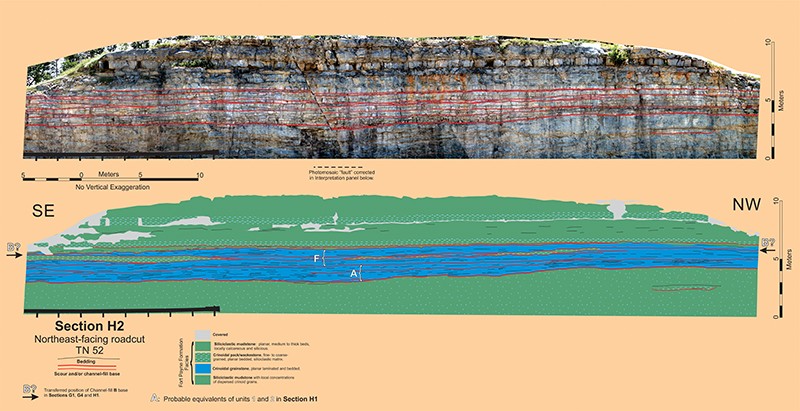Roadcut Sections H1 and H2
Sections H1 and H2 are only 50-meters across TN52 from each other; however, they expose very different stratigraphy. Channel-fill B from adjacent Sections G1 and G4 can be correlated into the upper southeastern part of Section H1, based on the occurrence of the distinctive silicified unit recognized at its base in the G1 and G4 sections; no such silicified layer occurs across TN52 in Section H2 and hence Channel-fill B cannot be confidently recognized. In Section H1 Channel-fill B consists solely of siliciclastic mudstone. The Section H1 crinoid grainstones 1 and 2 comprise a series of superposed or “nested”, mutually truncating, relatively high aspect-ratio channel-fills. Based on their planar, horizontal internal stratification vertical accretion was the dominant deposition mechanism, most likely from sediment gravity flows.
Section H1

The Section H2 crinoid grainstone groups A and F also comprise a series of superposed or “nested”, mutually truncating, relatively high aspect-ratio channel-fills. Based on their planar, horizontal internal stratification vertical accretion was the dominant deposition mechanism, most likely from sediment gravity flows. However, only group A can be correlated with some confidence, even across the 50-meter width of TN52, with Section H1 units 1 and 2. The group F channel-fills, although occupying the stratigraphic interval where Channel-fill B should be located (see the black arrow B? marker in Section H2) are questionable candidates to be coeval with Channel-fill B: a) the identifying silicified layer at the base of Channel-fill B in Section H1 is absent, and b) horizontal, continuous mudstone as comprises Channel-fill B in Section H1 is more likely to be continuous, over the 50-meter width of TN52, than are grainstone channel-fills.
Section H2
